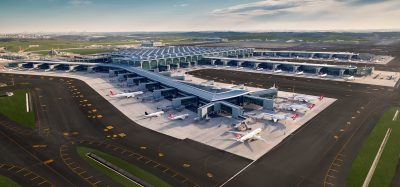A decade’s worth of perspective
- Like
- Digg
- Del
- Tumblr
- VKontakte
- Buffer
- Love This
- Odnoklassniki
- Meneame
- Blogger
- Amazon
- Yahoo Mail
- Gmail
- AOL
- Newsvine
- HackerNews
- Evernote
- MySpace
- Mail.ru
- Viadeo
- Line
- Comments
- Yummly
- SMS
- Viber
- Telegram
- Subscribe
- Skype
- Facebook Messenger
- Kakao
- LiveJournal
- Yammer
- Edgar
- Fintel
- Mix
- Instapaper
- Copy Link
Posted: 16 June 2005 | Anthony T. (Buzz) Cerino, U.S. Dept of Homeland Security, TSA, Office of Security Technology - Transportation Security Laboratory, Communications Technology Lead | No comments yet
Use of Radio Frequency Identification technology in the aviation industry has been a long time coming, but, writes Anthony Cerino, the wait is over with – probably.
Use of Radio Frequency Identification technology in the aviation industry has been a long time coming, but, writes Anthony Cerino, the wait is over with – probably.
When considering RFID technology it is important at the outset to differentiate between active and passive RF tags. Oversimplified, active tags generally have an on-board power source (for transmission of embedded data back to the reader and/or data storage) and cost significantly more than passive tags. Passive tags derive the energy needed to communicate directly from the reader, and hence can be much lower in cost, since they require no on-board power source. Although passive tags have a significantly reduced read-range of up to 10 metres, compared to hundreds of meters for active tags, they are ideally suited to applications such as single use disposable aviation baggage tags.
History of RFID for baggage
It is generally recognised that the Lufthansa Frankfurt / Hamburg trial in the early 1990’s ushered in the era of operational RF baggage tag trials. This effort utilised low frequency (kilohertz range) credit card-type tags, which at the time were bargain priced at a couple of dollars each, but required finely tuned costly readers the same size as modern explosives detection systems. Although accounts still differ on the resultant read rates from that trial, it proved that an RF tag could be affixed to passenger baggage, flown to another location, and its information accurately read upon arrival (surviving human and mechanical handling, and aircraft baggage compartment transit).
However, around the same time it became apparent that ‘low frequency’ tags (for the most part in the kilohertz (kHz) range), by virtue of their inherent technology, were lacking in both low cost tag volume projections and read range performance – not to mention the requirement for the costly ‘tunnel readers’. At the same time big technology companies also began packaging low-megahertz (MHz) frequency tags (essentially contact card technologies in the 5 to 15 MHz range), embedding them into paper baggage tag stock, and terming them RFID inlays. These RFID inlay tags proved much more compatible with airline baggage check-in operations, were priced below a dollar, were available from multiple sources and, on the surface, appeared to be ‘worldwide frequency compatible’. These tags still required bulky/costly tunnel readers and unfortunately proved to perform marginally (especially in some U.S. trials) relative to the evolving IATA Interline Baggage Tag RFID specification. In particular, many U.S. air carriers familiar with all available test data were unwilling to consider investment in what they considered marginally-performing technology – not to mention that they were being quoted prices in excess of 50 cents for these tags regardless of quantity. However, the 13.56 MHz RFID technology has survived that era and has in fact matured considerably in recent years. This technology still has the attention of some in the aviation industry, although that interest is waning rapidly.
The mid-to-late 1990’s saw a strong interest in gigahertz (GHz) frequency tags – specifically in the 2.45 GHz band. This technology proved to perform in excess of the evolving specification requirements (in most geographical regions) and required considerably simpler and inexpensive readers, with cost per tag as low as 25 to 30 cents. Yet, less than favourable power/bandwidth/modulation regulations in certain world regions, especially in Europe, meant this technology lacked worldwide acceptance.
Finally, the advent of the ultra-high frequency (UHF) ‘900 MHz’ band RF tags has brought certainty of cost at less than 20 cents per tag (and projected to go much lower as volumes increase) and readers which cost less than the 2.45 GHz readers. Range performance also exceeds the IATA specification requirement, and current standardization efforts point strongly to the potential (dare I say likely) worldwide solution. In particular, of late, the soon-to-be-ISO certified 900 MHz UHF EPCglobal Gen 2 standard should push the cost of disposable tags to under 10 cents. Furthermore many people project costs of under 5 cents within a year or so of operational adoption.
Today’s Situation
Several versions of 900 MHz products have been tested in operational trials, and have demonstrated outstanding performance. Regardless of which of these 900 MHz UHF tag/reader products is considered, there still is one unproven aspect – total worldwide interoperability.
The 900 MHz band actually spans discontinuous portions of the frequency range (depending on geographical region) from 865 MHz to 956 MHz. So the question that needs to be answered is … how can a frequency band which allocates small portions of a nearly 100 MHz total bandwidth and varies that frequency allocation from region to region (and also with varying power/bandwidth/modulation regulations) possibly be appropriate as a worldwide standard for aviation baggage tag use? The answer lies in the basic technologies and economics surrounding 900 MHz RFID technology versus technologies at other frequencies.
For reasons related to physics, integrated circuit manufacturing, mobile cellular industry emphasis, industry-elected interest in this band over other bands, and overall advances in low-powered communications systems design (including antennas and integrated circuits), these RFID products perform significantly better than systems at other frequencies – especially in the area of read range performance. Also, with read-range capabilities of up to 10 metres, the door is open to other commercial and security applications (some to be addressed later in this paper).
A path to the tag solution?
How does the aviation community develop enough confidence to vote in favor of a single RFID product for worldwide interoperable use? The answer is simple…it has to be demonstrated that it works!!!
The U.S. Transportation Security Administration (TSA), in cooperation with airlines, airports, IATA/ATA and many other worldwide governmental aviation authorities has taken steps to demonstrate this; the operational viability of exactly this 900 MHz band interoperability.
The TSA, primarily in conjunction with the Narita Airport Corporation, All Nippon Airlines, US Airways, and Aeroporti di Roma, in the summer of 2004 completed ‘two pieces’ of the interoperability demonstration by trialling an EPCglobal product with flights between Honolulu and Tokyo, and between Philadelphia and Rome. These showed conclusively that ‘mid-band 900 MHz’ U.S.-authorised programmed tags could be read at both the ‘high-band 900 MHz’ Japanese-authorised frequency band and the ‘low-band 900 MHz’ European-authorised frequency band. It also showed that they could be programmed in those two locations and then read in the U.S. However it failed to demonstrate complete low, mid, and high band interoperability – and that is exactly the emphasis of the TSA’s current trial (likely to already be in progress at the time of publication).
This trial involves United Airlines, Air China and Kenya Airways, Beijing Capitol Airport, Narita International Airport, Chicago O’Hare International Airport, Schiphol Airport Amsterdam and Jomo Kenyatta International Airport, Kenya. Additionally a host of others are providing equipment, integration, and test support. The trial is timed to provide the aviation industry with key performance data in advance of the anticipated International RFID Baggage Tag Specification vote in November, 2005.
Lessons learned
One of the most prevalent questions asked of anyone who has a measurable amount of ‘real world’ operational RFID baggage tag experience is: What are the lessons learned?
Any technology experiences development and operational stumbles when maturing and RFID is no exception. Although, we often hear of supply chain RFID applications and incorrectly conclude that the aviation industry’s needs and application of the technology are exactly the same — that isn’t the case! The aviation baggage handling environment no more resembles supply chain asset tracking than a Fiat resembles a Maserati. In aviation, nothing is consistent. As the saying goes (one that I’ve learned from many of my aviation industry colleagues)… “If you’ve seen one airport…you’ve seen one airport.”
In the supply chain world you’re likely to be operating in a very RF-limited, well-controlled environment, with parcel size consistency, where delivery orientation and tag positioning can sometimes be predicted like clockwork. In an operational airport, if any two bags/tag orientations are identical, it would be a minor miracle. Accordingly, most aviation RFID baggage tag systems must often co-exist with unknown, unmeasured and largely unregulated RF environments. They must also be capable of performing to near 100% read accuracy without knowledge of tag orientation, sometimes uncontrolled bag spacing, and with tags affixed to baggage of every conceivable size, shape and construction.
But, when integrated correctly, a baggage tag RFID system can easily rival and even exceed the most utopian supply chain RFID system results! The following are some of the known issues and, more importantly, some recommended solutions:
- Multiple RFID reader co-site compatibility: One must make certain all individual reader/tag radiation parameters are understood and care is given to ensure one reader doesn’t become the ‘otherwise non-existent interference source’ for another nearby. RFID, pure and simple, is wireless communications technology (though certainly on the lower end of the complexity scale of the genre) and must be implemented with an overall communication system mentality. .
- Tag reading order: If one of your operational requirements is to use tag reads as a decision criteria for directing bags to one of several choices in the flow process, it can be critical to read bags in the proper order and then divert as necessary. Stray reflection, inconsistent multi-path, or even poor antenna placement and reader power management could create a situation where tag read ordering is not exact. This can be avoided by doing the proper analysis prior to system implementation.
- Mobile and fixed readers: Occasionally airlines and airports initially see the need for RFID in the terms of fixed or mobile readers only. It is somewhat bewildering to comprehend how one would not foresee the obvious operational need for, and advantages of, having both fixed-site and mobile tag reading capabilities. Murphy’s Law clearly states that if you only have readers in certain locations, inevitably the need will soon arise to read tags in other locations.
- Tag issuing concerns: The issuing of RF baggage tags using industry standard/certified baggage tag printers has not been a straightforward process. However, if printer manufacturers, RFID suppliers and air carriers work together, I’m confident they can come to a mutually agreeable solution.
- Bottom-mounted antennas: These should be part of the chosen installation. Although most tags can be read from top and side, bottom antennas are valuable when tags end up on the bottom of a bag which has significant metal in direct contact with the tag.
Other possible applications
Even a total novice in this field cannot help but recognise that low cost, 10-meter range read range capability tag/reader combinations must have other operational applications beyond use as barcode baggage tag replacements.
In fact, the TSA, in cooperation with many others, has been addressing other RFID applications with potential to provide transportation cost, operational efficiency, and security benefits. Although the list here is a mere subset of the vast untapped RFID potential, the value in pursuing these uses can be easily recognised.
- Mobile direction finding / locating of baggage tagged items: A current TSA-sponsored effort specifically has the development and demonstration of a system capable of this as its exclusive objective.
- Complete system baggage tracking and accountabilility: A fully implemented and integrated RFID tracking system could provide the air carrier with valuable specific baggage location information to support decisions to delay or not delay flight departures. At some locations, limited baggage data exchange is in place, and the TSA, at more than one trial location, is currently planning cooperative data exchange with air carriers and airport authorities to disseminate RFID-derived baggage location data.
- Airport/Seaport Vehicle/Operator Identification, Location and Tracking: The TSA has on-going efforts to investigate the operational and security capabilities and advantages of this, along with the command centre and associated wireless communication network to facilitate this data, for use at air and sea ports.
- Smart Container Tags: A system similar to the vehicle tracking capability could be used for baggage or cargo containers — if not for cost and, more importantly, the issue of a ‘practical’ power source for the mobile container (the vehicle tracking system derives its power from the vehicle). Solar energy immediately comes to mind, as well as high capacity rechargeable batteries, along with ultra-efficient transmission schemes to maximize power usage efficiency. This concept, along with equipping the ‘smart container tag’ with the ability to read and “data manifest” (and hence locate) all passive UHF EPCglobal 900 MHz tags loaded within the smart container is another on-going TSA/industry cooperative effort.
- Airborne Cargo RFID: If it works for baggage it should work for cargo, mail and a host of other items as well….right? Yes, and for the most part, depending on the exact implementation and what local geographical regulations are in effect, one should expect performance similar to the near-100% read rates achievable at ranges similar to those expected for baggage systems. However, one big question still to be answered is whether some of the world’s more restrictive regional regulations (with limited bandwidth, modulation, and ‘out of carrier band’ rejection parameters, etc.) will allow adequate “high volume” read capabilities needed to potentially read hundreds of tags simultaneously (such as may occur on an airborne cargo pallet). The TSA is commencing cooperative air carrier and airport cargo RFID efforts to measure exactly this performance.
Conclusions and benefits
To summarise these are some of the known and anticipated benefits of RFID utilisation within the aviation industry:
- With the massive tag volumes expected from 900 UHF EPCglobal tag utilization, individual disposable tag costs should soon break the 10-cent barrier—spawning even more widespread acceptance and application diversity — leading to even greater volume cost reductions.
- Limited cost benefit analyses (and the TSA is embarking on another such analysis initially focused on baggage tags) indicate that an open-minded ‘complete business’ consideration for the use of RFID should quickly result in a positive return on investment.
- Full aviation RFID implementation would virtually eliminate nearly all mishandled and lost baggage.
- Pending standardization efforts will bring potential users the confidence of investment safeguarding.
- Lastly, it’s now more obvious than ever that the choice to use RFID more accurately may be ‘you can’t afford not to use it’ versus ‘can you afford to use it’.
Anthony T. (Buzz) Cerino
Anthony T. (Buzz) Cerino has a comprehensive academic background in Electrical Engineering from Drexel University, in Philadelphia, PA USA. He has over 34 years experience in electromagnetic compatibility assessments and the Test & Evaluation and Research & Development of communications, advanced sensors, antennas and security systems for the U.S. Government and federal/ commercial transportation entities.


















